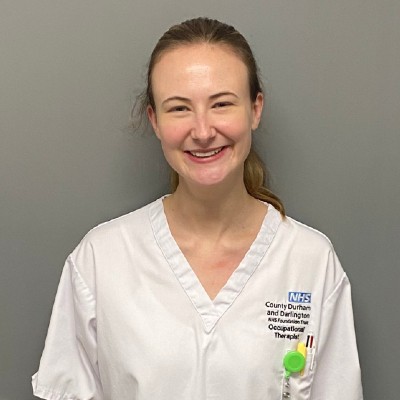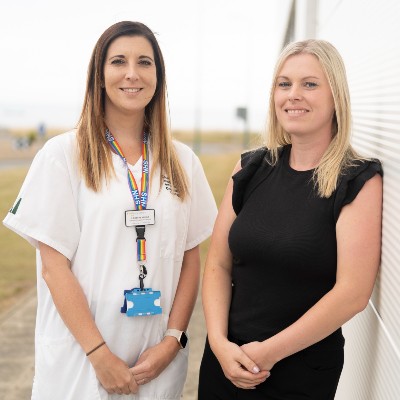Joanna Donnelly has been working as Occupational Therapist for 12 years working across both acute and community care groups. Throughout her career she developed a special interest in frailty, emergency care and improving the care of older people.
Joanna’s been with The Acute Frailty Team at Darlington for 3 years. Here’ she tells us about her typical day.
8am

There is a named co-ordinator for team for each day which is rotated around all staff.
Looks like it’s going to be a busy day, there are already more than people in the Emergency Department (ED) a full admissions ward and we are on OPEL (Operational Pressures Escalation Levels ) status 3, so high priority for looking at discharges and flow of patients across all sites.
The morning huddle involves checking that someone has had a Rockwood clinical frailty score completed at point of triage in ED, looking at what has brought someone into hospital, what interventions have been completed so far, where someone has been brought in to hospital from (own home, care home, respite or rehab setting), if there is any documentation about the patients usual level of function – this helps us to ensure the frailty score completed is accurate and if we are concerned that it is not we will add them to our list of score checks.
We create a list of patients to be seen from the huddle. This includes any new patients who are over 65 with a clinical frailty score of 5 or above or 4 with a frailty syndrome (admitted with fall, reduced mobility, urinary symptoms, new or fluctuating confusion), any reviews for patients who have remained on the ward overnight and any frailty score checks.
There is usually a staff member allocated for ED and this involves creating a list of patients who can be seen in ED. We try to split staffing up each day so that we have staff present in both ED and AMU. We work as a team throughout the day, utilising each other’s professional skills and ensuring that we are prioritising patients and keeping to date with the demand for frailty assessments.
Today, I am covering The Acute Medical Unit (AMU) but as you will see this is flexible and my day started on the ward but the demand later in the day was in ED.
The first patient I was allocated was a lady who was well known the acute frailty team, with frequent admissions for various reasons. This admission was a GP referral following a blood test showing low Haemoglobin and Iron. I was able to build a good rapport with the patient by clarifying her home environment and functional ability based on previous notes.
I reviewed her bloods, vital signs, cognitive screen, reviewed her bladder and bowels, fluid and dietary intake. The plan for the day was a further unit of red blood cells and iron infusion today. I agreed we would review her function following this and aim home ASAP. When her husband was present, we had a long discussion to ensure they were coping at home and determine if any further care or support was needed.
We also discussed resuscitation and escalation wishes together. This is part of our role which is so important for our frail older adults who are coming into hospital – it gives an opportunity for honest, realistic, open conversations. A further review will be needed later in the day post transfusion.
10am
The next patient was also on AMU, a lady who was admitted with two falls in 24 hours, a possible long lie, increased confusion and infection. Before going to see her, I completed a full review of her notes, reviewed her bloods, vital signs and looked at what diagnostics had been completed so far.
A fractured wrist was picked up in ED and already had a cast in place with a plan for orthopaedic review. A comprehensive geriatric assessment (CGA) was completed, this covered all the frailty elements, clinical assessment and review of body systems and cognitive screen. She was very tired throughout and history was limited – a collateral history from her son was key here.
A telephone call to her son was made, an opportunity to update him on the current diagnosis and treatment, admission details clarified including time and details of the falls, usual baseline and function, care support, usual cognition and an opportunity to discuss families concerns. The DNACPR for which was put in on a previous admission was also discussed to ensure her son was aware and in agreement of this.
This patient would require a hospital stay for IV antibiotics, fluids and ongoing therapy input. The ideal place of care was ward 7, the frailty specialist unit at Bishop Auckland (her hometown). A bed was agreed and handover completed.
11:30am and we all re-group to have a second huddle, we discuss the patients we have seen, any outstanding jobs, seek advice from colleagues and make a plan for the afternoon.
1pm
After lunch, ED is getting busier and the demand for frailty input is increasing. My next patient had been in the department for 6 hours, she had been reviewed by the medical team in ED and no acute medical reason for admission found. I completed a CGA and identified the main issues are high anxiety around falls, significant deconditioning, ability to manage at home since recent falls and worsening low mood.
A slight rise in inflammatory markers and some mild consolidation on chest x-ray also highlighted a chest infection requiring oral antibiotics only. The patient agreed to a period of rehabilitation and discharge planning for a short term POC to encourage routine and independence in her own home – the patient was transferred to a community hospital from ED for ongoing care.
Back to my lady from earlier with the low iron – her transfusions were now completed and she was feeling and looking much better. She agreed to a mobility review and sit out in the chair. We reviewed her bed transfers, toilet transfers and mobility with a wheeled walker as per her usual baseline. She managed really well, with some minimal prompting and assistance. The plan was for bloods early the next morning, another quick mobility review to ensure she is back at baseline and discharge home which she was very happy about.
6pm
The last assessment of the day was a joint assessment with one of my physio colleagues. This was a lady who had only been discharged 2 days ago, a 97 year old with a frailty score of 7, severely frail. She had been discharged with lots of equipment including a profiling bed, managing to transfer bed to commode and with a four times daily care package. She had been adamant she wanted to try at home however when she got home her overnight needs were unmanageable and she was admitted to ED following community crisis response with increased breathlessness and respiratory effort. Despite efforts made to access Reablement care home beds via RIACT (it was 7pm on a Sunday night!), she was transferred to Bishop Auckland Hospital step down ward for Social worker review on Monday and plan for 24 hour care placement.
A long but varied day in the life of an OT working in the Acute Frailty Team at Darlington. It has been a productive day getting people to the right places for ongoing care!
Read about a typical day in the lives of other Occupational Therapists working in different roles for both Durham County Council and the NHS:



Read their story

